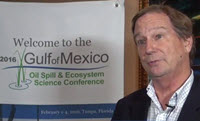The Three-Dimensional Gulf Circulation and Biogeochemical Processes Unveiled by State-of-the-Art Profiling Float Technology and Data Assimilative Ocean Models project is lead by Lynn K. (Nick) Shay, University of Miami.
The overarching goal of this proposed research is to build a rapid response capability that can be deployed in the event of an oil spill. The capability will consist of an integrated observation-prediction system to map the distribution and extent of hydrocarbons in the water column in real time and to quantify hydrocarbon removal and fate including short-term predictions of dispersion induced by the current field and transport of oil to the sea floor through scavenging by marine particles. Specific research objectives are (1) Observe fundamental physical and biogeochemical properties and processes using advanced state of- the-art measurement sensors on new profiling floats; (2) Integrate physical and biogeochemical processes in a coupled model that assimilates real-time data streams in the presence of strong currents; (3) Develop a flexible and carefully evaluated “end-to-end” predictive capability that can be deployed rapidly in case of subsurface oil spills to improve mitigation approaches by emergency responders and policy makers; and, (4) Quantify data and model uncertainties via a robust suite of realistic scenario simulations so that the final forecasted probability has well-understood sources of uncertainty. The prediction system will be evaluated in retrospective assimilation experiments using data from the Deepwater Horizon spill and in forecast experiments that assimilate satellite and float data in real time. Both will demonstrate the system’s capability, and improve our understanding of physical mechanisms and their impacts on the biogeochemistry in the water column.
To address the overarching goal, this group brings together technological development in ocean sensing, and their strategic deployments, modeling and data assimilation techniques, and analyses of data and simulations. The research team members have strong track records in their respective fields as shown on the CVs. The research group includes Dalhousie University, North Carolina State University, Teledyne-Webb Research and the University of Miami. In addition, the team intends to collaborate with the University of Miami’s CARTHE Program, which focuses mainly on measurements of surface processes.
By addressing the complexities of interacting physical and biogeochemical processes through integrated observation and prediction, this research has high potential for scientific as well as societal impacts ranging from possible application of the rapid response capability in the event of a spill and advancement of autonomous observation technology to improved predictions and process understanding. We will combine our collective expertise to develop and implement a rapid response product that is grounded in physical and biogeochemical measurements and their utilization in a coupled modeling framework in the eastern GoM. As part of this effort, we will contribute to training the next generation of scientists and engineers in building and deploying new technology that addresses Research Theme 4. The team members will work closely together to ensure that goals and objectives are met in a timely fashion. Data sets generated by this research will be provided to the GRIIDC group where data will be available to the GoMRI community. This transformative science, made possible through recent advances in autonomous platform and sensor technology, is needed given the complexities that were observed during DwH with subsurface plumes at depth and the southeastern GoM is may be exposed to new risks with possible drilling sites off the Cuba coast in the Straits of Florida. From this broader perspective, our highly experienced team is poised and ready to transcend the boundaries of traditional disciplines in addressing and mitigating present and future risks to our sensitive ecosystems.
Click for access to GoMRI’s YouTube videos of RFP-V Projects…
************
This project was funded by the Gulf of Mexico Research Initiative (GoMRI) in the RFP-V funding program.
The Gulf of Mexico Research Initiative (GoMRI) is a 10-year independent research program established to study the effect, and the potential associated impact, of hydrocarbon releases on the environment and public health, as well as to develop improved spill mitigation, oil detection, characterization and remediation technologies. An independent and academic 20-member Research Board makes the funding and research direction decisions to ensure the intellectual quality, effectiveness and academic independence of the GoMRI research. All research data, findings and publications will be made publicly available. The program was established through a $500 million financial commitment from BP. For more information, visit http://gulfresearchinitiative.org/.

